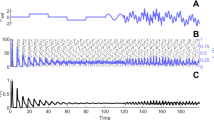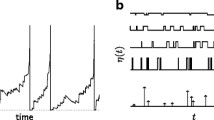Abstract
In this study, we apply a mean-field theory to reduce many synaptic inputs in order to investigate spiking behavior of a leaky integrate-and-fire neuron driven by periodic stimulations. Numerical simulations show that the bursting-like behavior of the spike train occurs only when the amplitude is large enough for low input frequency, which is modulated by the input frequency. We find that the stimulation can cause a delay in the response of the neuron to its injected current at high input frequencies.
Access provided by Autonomous University of Puebla. Download conference paper PDF
Similar content being viewed by others
Keywords
1 Instruction
In nervous systems, neurons convey information by action potentials. Although action potentials can vary somewhat in duration, amplitude, and shape, they are often considered as identical stereotyped events in neural coding. If we ignore the brief duration of an action potential, action potential is called a spike. A spike train can be characterized simply by a list of the times when spikes occur. Spike trains that can be evoked by the stimulus completely describe the relationship between a stimulus and neuronal response. Neuronal response variability evoked by deferent stimuli can be included in the variability of interspike intervals of the spike trains. Integrate-and- fire neuronal models are quite simple representations of the physiological properties of neurons, but still good description of the spiking activity of neurons [1, 2]. In the integrate-and-fire neuron model the state of the neuron is characterized by its membrane potential. The membrane potential receives synaptic inputs from other neurons by their associated synapses. When the membrane potential reaches a fixed threshold, an action potential is generated.
Neurons in nervous systems interact by synaptic connections. Neurons receive a continual stream of excitatory and inhibitory synaptic inputs. Up to now, many studies of the neural networks have treated the inputs from thousands of other neurons as a stochastic process [2]. To capture such complexity in a mathematically accessible model, the incoming spike trains are often assumed to be independent Poisson processes evoke a large number of tiny postsynaptic potentials [2, 3]. The mean-field theory can be introduced to reduce many synaptic connections to one connection; it enables us to analyze the effects of many synaptic connections in neural networks [4].
Brunel et al. [5] have investigated the firing frequency of an integrate-and-fire neuron with synaptic current dynamics. In particular, David et al. [6] have investigated the firing rate of integrate-and-fire neurons with synaptic dynamics. Tilo et al. [7] have studied the interspike interval statistics of a leaky integrate-and-fire neuron driven by Gaussian noise with large correlation times. The researches above mainly concentrated on the synaptic input. However, a realistic neuron receives natural sensory stimuli constantly; the firing rate of neuron driven by external stimulus is relevant to the neuronal information processing. Thus, it is necessary to investigate the spiking behavior of neuron driven by external stimulus in order to understand mechanism of neuronal coding.
2 Mathematical Model
The membrane potential \( V(t) \) of a leaky integrate-and-fire neuron obeys
In addition, a spike threshold is supplied.
If \( V > V_{\text{th}} \) then a spike occurs and \( V \) is reset to \( V_{\text{rest}} \).
Where \( \tau \) is a membrane time-constant, \( V_{\text{rest}} \) is the resting potential, \( I(t) \) is the external input current, \( t_{i} \) is the time of arrival of spike number \( i \) at synapse, and \( \sum\nolimits_{i} {\delta (t - t_{i} } ) \) is a sum of large number of synaptic inputs. We assume that the synaptic inputs represent a Poisson train of synaptic inputs with a rate \( \lambda \) in Hz [3], each individual synaptic input can produce a small postsynaptic potential \( \Delta V \) = 0.1 mv, the external input current is the periodic input \( I(t) = r\;\cos \;\upomega{\text{t}} \), the initial membrane potential \( V(0) = - 70 \) mv at time \( t = 0 \). For subthreshold potentials, the response of the model neuron to periodic deterministic input is
3 Numerical Simulations
As we consider the response of LIF neuron to external stimulus, it is difficult to use a mathematical description of the membrane potential dynamics to analyze the interspike interval distribution of the leaky integrate-and-fire neuron with firing threshold. Therefore, numerical simulations were performed to investigate the output spikes of the leaky integrate-and-fire neuron in the presence of an external stimulus.
To investigate the dependence of the spiking response on the amplitude of the periodic stimulation, we vary the amplitude of the stimulation and let \( \lambda = 1000 \), \( \tau = 10 \), \( \omega = 2 \). For the small amplitudes of the stimulation, the out spiking responses have no distinctive differences (Fig. 114.1a–c). However, for a larger amplitude of the stimulation, the bursting-like behavior of the spike train occurs (Fig. 114.1d).
To investigate the dependence of the spiking response on the frequency of stimulation, the output responses of the IF neuron to the stimulations were plotted as a function of time. Here we set \( \lambda = 1000 \), \( \tau = 10 \), \( r = 1000 \). For low input frequencies, the output spiking of the neuron is tonic bursting behavior, which is modulated by the input frequency (Fig. 114.2a, b). With the increasing frequency of stimulations, the spiking train transforms from the bursting to the approximate periodic firing (Fig. 114.2c). The stimulations can cause a delay in the response of the neuron to its injected current at high input frequencies (Eq. 114.2). It can be seen that the interspike interval in the final part of the spike train is increasing (Fig. 114.2c, d).
4 Conclusions
We reduced many synaptic inputs to one mean input by using the mean-field theory. A simplified integrate-and-fire neuron model was used to simulate the spiking response of the neuron driven by external periodic inputs. The dependence of the spiking response on the frequency and amplitude of stimulation was investigated. We have found that the low input frequency and the larger amplitude of stimulation play a fundamental role in spiking response of neuron driven by external stimulation. For low input frequency, the larger amplitude of stimulation can cause bursting-like behavior of the spike train, which is modulated by the input frequency. The stimulations can cause a delay in the response of the neuron to its injected current at high input frequencies.
References
Tuckwell, H.: Introduction to theoretical neurobiology: volume 2, nonlinear and stochastic theories. Cambridge University Press, Cambridge (1988)
Burkitt, A.N.: A review of the integrate-and-fire neuron model: I Homogeneous synaptic input. Biol. Cybern. 95(1), 1–19 (2006)
Liu, Y.H., Wang, X.J.: Spike-frequency adaptation of a generalized leaky integrate-and-fire model neuron. J. Comput. Neurosci. 10(1), 25–45 (2001)
Chen, C.C., Jasnow, D.: Mean-field theory of a plastic network of integrate-and-fire neurons. Phys. Rev. E 81(1), 011907 (2010)
Brunel, N., Sergi, S.: Firing frequency of leaky intergrate-and-fire neurons with synaptic current dynamics. J. Theor. Biol. 195(1), 87–95 (1998)
David, A., Takaaki, M.: Firing rate of noisy integrate-and-fire neurons with synaptic current dynamics. Phys. Rev. E 80, 021933 (2009)
Tilo, S., Lutz, S.G.: Interspike interval statistics of a leaky integrate-and-fire neuron driven by Gaussian noise with large correlation times. Phys. Rev. E 77, 031914 (2008)
Acknowledgments
This work was supported by the National Natural Science Foundation of China under Grant No. 11232005 and No. 11172086.
Author information
Authors and Affiliations
Corresponding author
Editor information
Editors and Affiliations
Rights and permissions
Copyright information
© 2016 Springer Science+Business Media Singapore
About this paper
Cite this paper
Wang, J., Jiao, X., Zhao, W. (2016). Spiking Response of a Leaky Integrate-and-Fire Neuron Driven by Periodic Inputs. In: Wang, R., Pan, X. (eds) Advances in Cognitive Neurodynamics (V). Advances in Cognitive Neurodynamics. Springer, Singapore. https://doi.org/10.1007/978-981-10-0207-6_114
Download citation
DOI: https://doi.org/10.1007/978-981-10-0207-6_114
Published:
Publisher Name: Springer, Singapore
Print ISBN: 978-981-10-0205-2
Online ISBN: 978-981-10-0207-6
eBook Packages: Biomedical and Life SciencesBiomedical and Life Sciences (R0)






